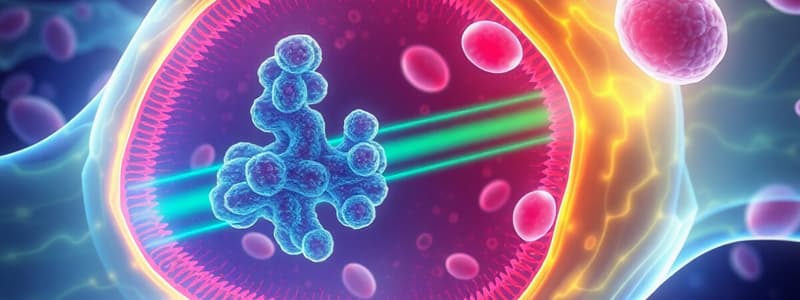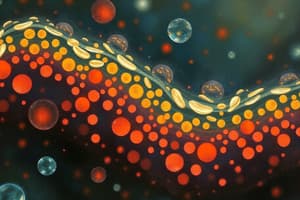Podcast
Questions and Answers
What characteristic of the plasma membrane allows it to regulate the exchange of materials between a cell and its environment?
What characteristic of the plasma membrane allows it to regulate the exchange of materials between a cell and its environment?
- Impermeability to all molecules
- Presence of a rigid cell wall
- Selective permeability (correct)
- Uniform permeability to all substances
The hydrophobic core of the phospholipid bilayer primarily restricts the movement of what type of molecules across the cell membrane?
The hydrophobic core of the phospholipid bilayer primarily restricts the movement of what type of molecules across the cell membrane?
- Small polar molecules
- Hydrophobic molecules
- Ions and charged molecules (correct)
- Nonpolar molecules
Which of the following transport mechanisms requires the assistance of membrane proteins but does not require energy input?
Which of the following transport mechanisms requires the assistance of membrane proteins but does not require energy input?
- Facilitated diffusion (correct)
- Osmosis
- Simple diffusion
- Active transport
How does the concentration gradient affect the rate of diffusion across a membrane?
How does the concentration gradient affect the rate of diffusion across a membrane?
What causes water to move across a selectively permeable membrane during osmosis?
What causes water to move across a selectively permeable membrane during osmosis?
What is the state of equilibrium in passive transport?
What is the state of equilibrium in passive transport?
Why are transport proteins necessary for facilitated diffusion?
Why are transport proteins necessary for facilitated diffusion?
How do channel proteins facilitate the transport of ions and small polar molecules?
How do channel proteins facilitate the transport of ions and small polar molecules?
What is the primary difference between passive and active transport?
What is the primary difference between passive and active transport?
Which of the following is an example of primary active transport?
Which of the following is an example of primary active transport?
What is the role of ATP in primary active transport?
What is the role of ATP in primary active transport?
What electrochemical gradients does the sodium-potassium pump establish?
What electrochemical gradients does the sodium-potassium pump establish?
In the Sodium-Potassium pump, how many sodium ions (Na+) are moved out of the cell for every two potassium ions (K+) moved in?
In the Sodium-Potassium pump, how many sodium ions (Na+) are moved out of the cell for every two potassium ions (K+) moved in?
What is the source of energy for secondary active transport?
What is the source of energy for secondary active transport?
What is the difference between symport and antiport?
What is the difference between symport and antiport?
Which of the following is an example of bulk transport?
Which of the following is an example of bulk transport?
What is the primary function of endocytosis?
What is the primary function of endocytosis?
How does receptor-mediated endocytosis differ from phagocytosis and pinocytosis?
How does receptor-mediated endocytosis differ from phagocytosis and pinocytosis?
What is the main purpose of exocytosis?
What is the main purpose of exocytosis?
What cellular process is defective in familial hypercholesterolemia?
What cellular process is defective in familial hypercholesterolemia?
Flashcards
Plasma Membrane
Plasma Membrane
A selectively permeable barrier that regulates the exchange of materials between the cell and its surroundings.
Phospholipid Bilayer
Phospholipid Bilayer
Basic membrane structure with a hydrophobic core, acting as a barrier to many substances.
Membrane Proteins
Membrane Proteins
Assist in transport, cell signaling, and recognition within the membrane.
Homeostasis
Homeostasis
Signup and view all the flashcards
Nonpolar Molecules
Nonpolar Molecules
Signup and view all the flashcards
Simple Diffusion
Simple Diffusion
Signup and view all the flashcards
Osmosis
Osmosis
Signup and view all the flashcards
Facilitated Diffusion
Facilitated Diffusion
Signup and view all the flashcards
Active Transport
Active Transport
Signup and view all the flashcards
Primary Active Transport
Primary Active Transport
Signup and view all the flashcards
Phosphorylation (in active transport)
Phosphorylation (in active transport)
Signup and view all the flashcards
Sodium-Potassium Pump
Sodium-Potassium Pump
Signup and view all the flashcards
Secondary Active Transport
Secondary Active Transport
Signup and view all the flashcards
Symport
Symport
Signup and view all the flashcards
Antiport
Antiport
Signup and view all the flashcards
Endocytosis
Endocytosis
Signup and view all the flashcards
Phagocytosis
Phagocytosis
Signup and view all the flashcards
Pinocytosis
Pinocytosis
Signup and view all the flashcards
Receptor-Mediated Endocytosis
Receptor-Mediated Endocytosis
Signup and view all the flashcards
Exocytosis
Exocytosis
Signup and view all the flashcards
Study Notes
Overview of Biological Membranes and Transport
- The plasma membrane is a selectively permeable barrier.
- It controls the exchange of substances between a cell and its environment.
- A phospholipid bilayer with a hydrophobic core forms the membrane's basic structure, acting as a barrier.
- Membrane proteins aid in transport, cell signaling, and recognition processes.
- Cells maintain homeostasis by carefully controlling transport across their membranes.
Selective Permeability
- Not all molecules cross membranes equally easily.
- Nonpolar molecules like O₂, CO₂, and steroid hormones easily diffuse due to interactions with the hydrophobic interior.
- Small polar molecules like water and ethanol can cross, but at a slower rate due to interactions with hydrophobic tails.
- Large polar molecules like glucose need transport proteins to cross the hydrophobic core.
- Ions and charged molecules such as Na⁺, Cl⁻, and Ca²⁺ are highly impermeable due to their charge, needing specialized proteins.
Passive Transport
- Passive transport does not require energy.
Simple Diffusion
- Molecules move from high to low concentration, following the gradient until equilibrium.
- Equilibrium is dynamic with molecules moving in both directions, maintaining equal concentration.
- A steeper concentration gradient increases diffusion rate.
- Higher temperatures increase diffusion rates.
- Smaller molecules diffuse faster than larger ones.
Osmosis (Water Transport)
- Water moves across a selectively permeable membrane from an area of lower solute concentration to higher.
- Water moves to bind to solutes, reducing free water molecules on the solute-rich side.
- Osmosis causes volume changes, increasing volume on the side with higher solute and decreasing it on the other side.
- Equilibrium is reached when solute concentrations are equal.
Facilitated Diffusion
- Uses transport proteins, requiring no energy input.
- Diffusion is driven by the concentration gradient.
- Transport proteins shield substances from the hydrophobic core.
- Channel proteins are used by ions and small polar molecules to move through hydrophilic passageways.
- Carrier proteins bind certain target molecules, changing shape to move them across.
- Highly specific carrier proteins recognize just one type of molecule.
Active Transport
- Active transport requires energy.
Overview of Active Transport
- Substances are moved against the concentration gradient, from low to high concentration.
- It requires ATP input
- Active transport maintains ion gradients, nutrient uptake, and waste removal.
Primary Active Transport
- Uses ATP to directly power the transport.
- ATP donates a phosphate group to the transport protein.
- Phosphorylation leads to a change in the protein's shape.
- This shape change enables the protein to pump substances against their concentration gradient.
Sodium-Potassium Pump (Na+/K+ Pump)
- The sodium-potassium pump is a primary active transport system.
- It moves 3 Na⁺ out and 2 K⁺ into the cell, against their respective gradients.
- The first step occurs when 3 Na⁺ bind to the pump inside the cell.
- Secondly, ATP phosphorylates the pump, inducing a shape change.
- Thirdly, the pump releases 3 Na⁺ outside the cell, then 2 K⁺ bind to the pump from the outside.
- The process continues as phosphate is released, causing another change.
- Finally, the pump releases 2 K⁺ inside the cell.
- The result is high [Na⁺] outside and high [K⁺] inside, creating electrochemical gradients.
Secondary Active Transport
- Uses energy stored in ion gradients created by primary active transport.
- Symport involves two substances moving together in the same direction, like Na⁺-glucose co-transport.
- Antiport involves one substance moving in while another moves out, like the Na⁺-Ca²⁺ exchanger.
Bulk Transport
- Bulk Transport requires energy.
Endocytosis
- Membrane vesicles engulf materials.
- Phagocytosis involves engulfing large particles, for instance, immune cells consuming bacteria.
- Pinocytosis involves taking in extracellular fluid and dissolved solutes.
- Receptor-Mediated Endocytosis: surface receptors bind to specific molecules before engulfment.
- Defective LDL uptake results in familial hypercholesterolemia, leading to high blood cholesterol.
Exocytosis
- Vesicles fuse with the plasma membrane, releasing contents.
- Functions include hormone secretion, neurotransmitter release, and waste elimination.
Studying That Suits You
Use AI to generate personalized quizzes and flashcards to suit your learning preferences.




